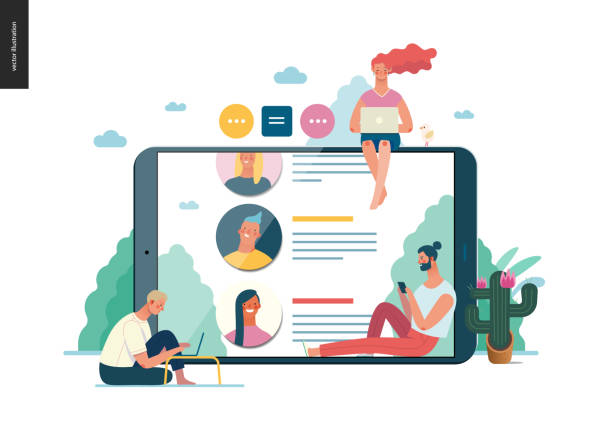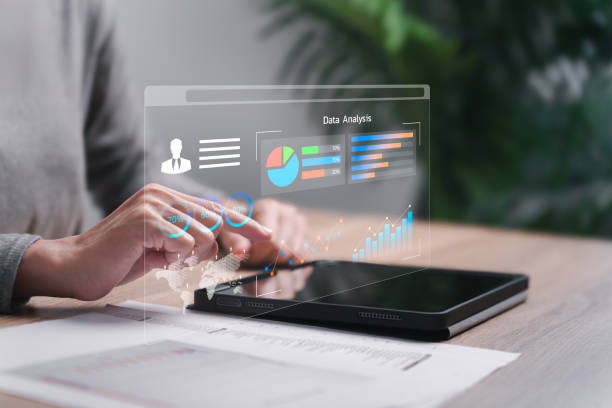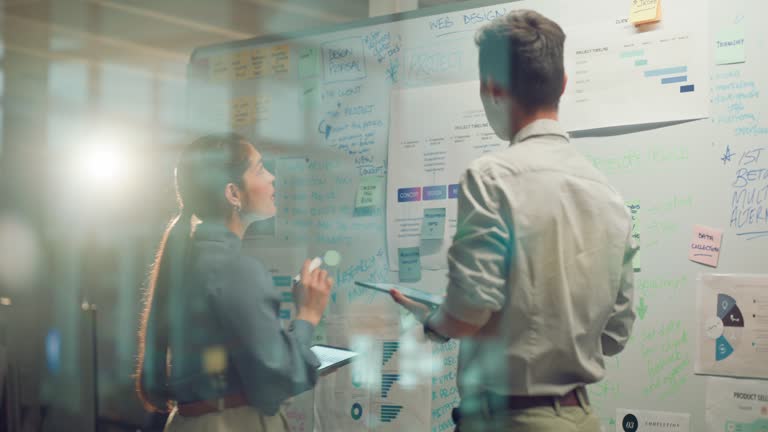The Unrivaled Importance of Modern UI Website Design in Today’s World

In the current digital age, where competition for user attention has intensified more than ever, website design is not merely about creating an online presence, but about crafting a memorable and efficient user experience.
Modern UI website design and user experience (UI/UX) play a pivotal role in this journey.
This approach goes beyond mere aesthetics, addressing how a user interacts with your website, how easy and enjoyable this interaction is, and to what extent they achieve their goals.
In today’s world, websites are no longer just information platforms; they are powerful tools for communication, sales, and service delivery.
Therefore, the importance of UI/UX is doubled.
Poor design can lead to high bounce rates, decreased engagement, and ultimately, loss of customers, while modern UI website design can help improve conversions, increase user satisfaction, and strengthen brand loyalty.
This section provides an explanation of why this topic is important and serves as a comprehensive guide to help you better understand this crucial concept.
#UIUX #Web_Design #User_Experience #Modern_User_Interface
Tired of losing customers due to poor e-commerce website design? With Rasawb, solve this problem forever!
✅ Increase sales and visitor-to-customer conversion rates
✅ Smooth and engaging user experience for your customers⚡ Get Free Consultation
Fundamental Principles in Creating a Novel User Experience

Modern UI website design is based on a set of fundamental principles aimed at enhancing user experience and increasing website efficiency.
The first and most important principle is user-centricity; meaning all design decisions must consider users’ needs, behaviors, and expectations.
This principle requires extensive user research and a deep understanding of their psychology.
The second principle is simplicity and intuitiveness.
A modern user interface should be so simple and understandable that a user can easily interact with it and achieve their goal without needing special training.
Avoiding unnecessary complexities and focusing on key user paths are prominent features of this approach.
Accessibility is another vital principle; the website must be usable for all users, regardless of physical abilities or technological limitations.
This includes complying with necessary standards for people with disabilities and compatibility with various devices and browsers.
Finally, immediate feedback is also an important principle; the system should always provide appropriate feedback to the user about the status of their activities.
This educational and specialized section provides deep insights into the main pillars of modern UI/UX design.
Visual Transformations and Aesthetic Trends in User Interface

The look and feel of a website are the first things that attract users, and for this reason, visual trends in modern UI website design are of high importance.
In recent years, we have witnessed significant changes in web aesthetics.
One of the most prominent of these trends is minimalism; the use of ample white space, legible fonts, and limited color palettes aimed at creating a clean, uncluttered, and distraction-free user experience.
This approach helps the user focus on the main content.
Dark Mode has also become extremely popular, which is not only visually appealing but can also help reduce eye strain in low-light environments.
The use of high-quality images and videos, as well as subtle animations and microinteractions, adds to the visual appeal and dynamism of the website.
Typography plays a crucial role in conveying brand identity and personality, and the selection of appropriate fonts and their combinations significantly contributes to text readability and aesthetics.
This section includes news and analytical information about the latest design trends.
Comparison of Classic and Modern UI Design Elements
| Feature | Classic Design | Modern Design |
|---|---|---|
| Whitespace | Low, full of content and elements | Ample and purposeful for focus |
| Color Scheme | Usually extensive palettes, many shadows | Limited palettes, flat colors, subtle gradients |
| Typography | System fonts, low variety | Custom web fonts, emphasis on readability and hierarchy |
| Interactivity | Limited, click-based | Microinteractions, animations, visual feedback |
User Experience (UX) Beyond Appearance

While User Interface (UI) addresses the visual and interactive aspects of a website, User Experience (UX) encompasses the entire feeling and perception of the user’s interaction with the product.
Modern UI website design cannot succeed without a strong UX.
A deep understanding of UX requires precise processes such as user research.
This research includes interviews, surveys, and analysis of behavioral data to identify user needs, problems, and pain points.
After data collection, the phase of creating user personas begins, which are hypothetical representations of target users and help the design team design with greater empathy.
Information Architecture is also a vital part of UX that deals with the logical organization of content and website navigation so users can easily find the information they need.
Designing User Flows and Sitemaps are also important tools in this phase.
All these processes help create a smooth, efficient, and satisfying experience for the user.
This specialized and guiding section delves into the hidden aspects of UX.
Does your current corporate website not reflect your brand’s credibility and strength as it should? Rasawb solves this challenge for you with professional corporate website design.
✅ Increase visitor credibility and trust
✅ Targeted attraction of more customers
⚡ Click to get free consultation!
Interactive Elements and Microinteractions: The Key to Improving User Engagement

Microinteractions are small details that play a big role in modern UI website design.
These small interactions, such as a button changing color when hovered over, a loading animation, or haptic feedback when touching a mobile screen, seem minor but significantly impact user experience.
They not only make the website more dynamic and engaging but also convey important visual information to the user.
For example, a successful animation after form submission assures the user that their operation has been completed successfully.
Microinteractions give users a greater sense of control and help them understand the outcomes of their actions.
These interactive elements can also act as guides, directing the user toward the next action.
The precise and purposeful design of these details can make a significant difference in user engagement and satisfaction and transform the website from a static page into a live, responsive experience.
This aspect of modern UI website design demonstrates attention to detail that is often overlooked.
This entertaining and explanatory section reveals the hidden charms of UI/UX.
Performance and Optimization: A Vital Role in Website Success

Beauty and user-friendliness are only part of the modern UI website design equation; website performance is equally important.
Page loading speed and the smoothness of interactions directly impact user experience and even search engine rankings.
A slow website frustrates users and causes them to leave before the page fully loads.
Image optimization, use of optimized code, file compression, and leveraging Content Delivery Networks (CDNs) are among the solutions that help improve website speed.
Search Engine Optimization (SEO) is also inextricably linked to website performance.
Search engines give higher rankings to websites that have high speed and provide a good user experience.
These optimizations not only help attract more traffic but also improve conversion rates.
Users are more likely to make a purchase or enter their contact information on a website that is fast and responsive.
This analytical and specialized section addresses the technical aspects of modern UI website design.
Mobile-First: A Priority in Responsive Design

With the increasing use of mobile devices for internet access, the “Mobile-First” approach has become a golden standard in modern UI website design.
This means that the website design and development process should start with the smallest screens (like smartphones) and then gradually expand to tablets and desktop computers.
This method ensures that the user experience on mobile devices, which often come with limitations such as smaller screens, lower internet speeds, and touch interaction, is optimized and efficient.
Responsive Design also plays a pivotal role in this area, allowing the website to automatically adjust to the user’s device screen size and provide the best possible display.
This includes flexibility in layout, font sizes, and images.
A website that is properly optimized for mobile not only provides a better user experience but is also highly important for SEO, as Google prioritizes mobile-friendly websites.
This educational and guiding section provides you with the necessary tools for success in the mobile world.
Principles of Responsive Design for Various Devices
| Device Type | Design Features | Key UX Considerations |
|---|---|---|
| Mobile (Smartphones) | Single-column design, large touch buttons, simple navigation | Fast loading, short forms, concise content |
| Tablet (Tablets) | Two or three-column layout, utilization of more space | Advanced touch interaction, image galleries |
| Desktop (Desktops) | More complex layout, extensive menus, hover effects | Ample user space, rich content, mouse and keyboard interaction |
Advanced Tools and Technologies in UI/UX Design

To implement modern UI website design, familiarity with and use of cutting-edge tools and technologies are essential.
In the field of User Interface (UI) design, software such as Adobe XD, Figma, and Sketch allow designers to create interactive prototypes and wireframes.
These tools enable team collaboration, creation of reusable components, and rapid testing of ideas.
In the User Experience (UX) section, user behavior analysis tools like Hotjar and Google Analytics help collect valuable data about how users interact with the website.
This data includes heatmaps, user session recordings, and click paths, which provide deep insights for UX improvement.
In front-end development, modern CSS frameworks like Tailwind CSS and Bootstrap, and JavaScript libraries such as React, Vue.js, and Angular, help developers implement complex and interactive user interfaces with high speed and efficiency.
These tools and frameworks are the foundation for building dynamic and responsive websites that provide a flawless user experience.
This specialized and guiding section introduces the most commonly used tools in this field.
Are you tired of your e-commerce website having visitors but no sales? Rasawb solves your main problem with professional e-commerce website design!
✅ Significant sales increase with purposeful design
✅ Flawless user experience for your customers
⚡ Get a free consultation!
Challenges and Future Research in Modern User Interface Design

Despite all advancements, modern UI website design also comes with challenges.
One of the most significant challenges is the increasing complexity of user expectations.
Today’s users quickly adapt to new technologies and expect every website they encounter to provide a flawless user experience.
This puts pressure on designers to constantly innovate.
Another challenge is maintaining the balance between aesthetics and performance.
A website must be both beautiful and operate quickly and efficiently.
Compatibility with various devices and browsers is also an ongoing challenge that requires precise and continuous testing.
However, the future of modern UI website design also looks very exciting.
Artificial Intelligence (AI) and Machine Learning (ML) will play an increasing role in personalizing the user experience, allowing websites to tailor their content and layout based on each user’s individual behavior and preferences.
Virtual Reality (VR) and Augmented Reality (AR) also hold great potential for creating interactive and immersive web experiences.
Furthermore, Voice User Interfaces (Voice UIs) and Gesture Control are gaining popularity and can offer new ways to interact with websites.
This thought-provoking and news-oriented section explores new horizons in this field.
The Impact of Modern UI Website Design on Branding and Business Success

In today’s competitive business environment, modern UI website design is no longer a luxury feature but a strategic necessity.
Your website is the first point of contact for many customers with your brand, and the user experience you provide directly impacts their perception of your brand.
A well-designed website conveys a sense of professionalism, trustworthiness, and attention to detail.
This helps build customer trust and loyalty.
Conversely, a poorly designed website can quickly lead to a loss of credibility and drive potential customers towards competitors.
Furthermore, an optimized UI/UX can help improve the Conversion Rate.
By simplifying purchasing, registration, or contact paths, the website can easily encourage users to take desired actions.
This means increased sales, more lead generation, and ultimately business growth.
Investing in modern UI website design not only helps improve user experience but also acts as a strategic investment for long-term business success.
This analytical and specialized section clarifies the connection between design and financial outcomes.
Frequently Asked Questions
| Question | Answer |
|---|---|
| What is modern UI website design? | It is an approach to website design that focuses on clean aesthetics, simplicity, high usability, and delivering a visually appealing and pleasant user experience (UX). |
| What are the key elements of a modern web UI? | Flat Design, intelligent use of white space, appealing typography, intuitive navigation, high-quality images, and responsiveness are key elements. |
| Why is using a modern UI important in website design? | It attracts and retains users, increases brand credibility, improves conversion rates, and provides a smooth and pleasant user experience. |
| How does modern User Interface (UI) affect User Experience (UX)? | Modern UI directly improves user experience by creating a beautiful, organized, and understandable environment, making interaction easier. |
| What is the role of typography in modern UI design? | Typography is crucial for readability, creating information hierarchy, conveying brand essence, and the overall visual appeal of the site. |
| How is Responsive Design related to modern UI? | Responsive design is an integral part of modern UI because it ensures that the site’s appearance and functionality are consistent and optimal across all devices (mobile, tablet, desktop). |
| What are the current trends in modern web UI design? | Dark Mode, subtle animations, creative use of white space, prominent typography, and the use of asymmetrical graphic elements are among recent trends. |
| How can one ensure that a modern UI has high Usability? | By conducting user testing, simplifying navigation, providing clear Calls to Action (CTAs), improving loading speed, and focusing on Accessibility. |
| What is the main difference between UI and UX in modern design? | UI is the look and feel of the site (user interface), while UX is the overall user experience when interacting with the site. UI is considered a part of UX. |
| What tools are used for modern web UI design? | Common tools such as Figma, Sketch, Adobe XD, Photoshop, and Illustrator are used for modern UI design and prototyping. |
And other services of Rasawb Advertising Agency in the field of digital advertising
Intelligent Branding: A combination of creativity and technology for campaign management through attractive UI design.
Intelligent Link Building: Revolutionize SEO ranking with the help of real data utilization.
Intelligent Sales Automation: Revolutionize SEO ranking with the help of attractive UI design.
Intelligent Social Media: A combination of creativity and technology to increase click-through rates through precise audience targeting.
Intelligent SEO: A novel service for increasing online growth through key page optimization.
And over hundreds of other services in the fields of internet advertising, advertising consulting, and organizational solutions
Internet Advertising | Advertising Strategy | Advertorial
Resources
- User Experience Design Articles – Iran Digital
- Modern Website Design Articles – Websoft
- Website User Interface Guide – Parsian Web
- UI/UX Design Training – Hamyaran Web
? Are you ready to transform your business in the digital world? Rasawb Afarin, with expertise in secure website design and comprehensive digital marketing services, is your reliable partner for reaching the pinnacles of success.
📍 Tehran, Mirdamad Street, next to Central Bank, Southern Kazeroun Alley, Ramin Alley, No. 6


